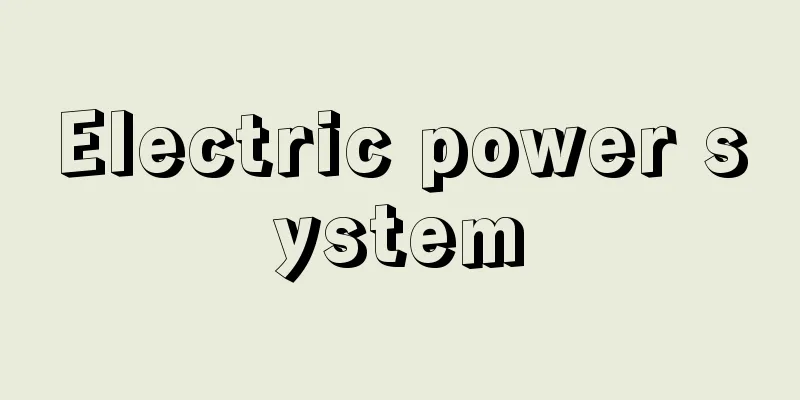Electric power system

|
A general term for the entire system of power plants, transmission lines, substations, distribution lines, and control systems for generating, transporting, and supplying electricity to consumers. The generators that generate electricity are mainly hydroelectric, thermal, and nuclear, with some also using geothermal, wind, and solar power. Hydroelectric power plants use the energy generated by water falling from a high place to turn a generator and generate electricity, and are built in mountainous areas with a high head and abundant water. Thermal power plants burn petroleum fuels such as heavy oil, crude oil, and naphtha, gas fuels such as LNG (liquefied natural gas) and LPG (liquefied petroleum gas), coal-based pulverized fuels, or a new type of coal-based fuel called COM (coal oil mixture, or coal-oil slurry), and use the steam energy to turn a generator to generate electricity. Initially, they were built near consumers, but due to environmental pollution concerns, they have gradually become more remote, and in some cases are 100 to 200 kilometers away from the demand area. Nuclear power plants work by fissioning uranium in a reactor and using the resulting thermal energy to generate electricity, and from the outset, they are often built in locations as far away as 200 to 400 kilometers from centers of demand. In a power system, the generation and consumption of electricity must always match. If they do not match, the frequency will fluctuate, which will have adverse effects such as changing the number of revolutions of motors. For this reason, it is necessary to combine the electricity generated at each power plant with a transmission line and control it so that generation and consumption always match. The optimum voltage for the generator is 10 to 20 kilovolts in terms of the cost required for insulation, and the voltage used in ordinary households is 100 volts mainly for safety reasons. The higher the voltage, the more efficient the transportation of electricity from a distant power plant. When transporting a certain amount of electricity, the higher the voltage, the less current will flow, and the less loss there will be. In order to organically combine these, the voltage is increased by a transformer at the power plant, and then it is transported to a substation near the consumer using a transmission line, where the voltage is gradually reduced, and ordinary households are supplied with a voltage of 100 to 200 volts. Good quality electricity, that is, electricity with voltage and frequency maintained as close to specified values as possible, is desirable, so the generated power is adjusted to match consumption to maintain a constant frequency, and the voltage is also adjusted precisely. Since power systems supply electricity to consumers using transmission lines from power plants scattered around the country, they are constantly exposed to natural threats such as lightning, snow, and flying objects, so it is important to minimize power outages and damage in the event of an accident. For this reason, power system equipment is designed to reinforce each piece of equipment, and multiple transmission lines and transformers are installed so that in the unlikely event of an accident occurring in one piece of equipment, only that equipment will be shut down, and power outages for consumers will not occur. In addition, when an accident occurs, the system is equipped with a protective relay system that immediately isolates only the section that has the accident (fault removal) and prevents the accident from spreading. [Naoyuki Uchida] [Reference] | | | |Source: Shogakukan Encyclopedia Nipponica About Encyclopedia Nipponica Information | Legend |
|
電力の発生、輸送、需要家への供給のための、発電所、送電線、変電所、配電線などと制御システムの全体を総称していう。電力を発生する発電機としては、水力、火力、原子力によるものが主体であり、一部、地熱、風力、太陽光などがある。水力発電は、水が高いところから下に落ちるときのエネルギーを利用して発電機を回し電気をおこすもので、高落差かつ豊富な水量が得られる山地に建設される。火力発電は、重油、原油、ナフサなどの石油系燃料、LNG(液化天然ガス)、LPG(液化石油ガス)などのガス燃料、石炭を微粉炭とした燃料、あるいは石炭を使用した新しいCOM(coal oil mixture=石炭・石油スラリー)などを燃焼させ、その蒸気エネルギーで発電機を回して電気をおこすものである。当初は需要家近傍に建設されていたが、環境汚染の面から逐次遠隔化し、需要地から100キロ~200キロメートルも離れている場合がある。原子力発電は、原子炉の中でウランを核分裂させ、発生する熱エネルギーを発電に利用するもので、当初から需要の中心地より200キロ~400キロメートルの遠隔地に建設されることが多い。 電力系統では電力の発生と消費をつねに一致させなければならない。一致していない場合は周波数が変動し、これによってモーターの回転数が変わるなどの悪影響が生じる。このため、各発電所で発生する電力を送電線にて結合させ、発生と消費をつねに一致するよう制御する必要がある。発電機の発生電圧は絶縁に要するコストの面から10キロ~20キロボルトが最適であり、一般家庭の電圧は主として安全性の面から100ボルトが用いられる。遠隔の発電所からの電力の輸送のためには高電圧化するほど効率的となる。所定の電力を輸送する場合、電圧が高いほど流れる電流が少なくなり、この分損失が少なくなる。これらを有機的に結合するため、発電所においては変圧器によって高電圧化し、送電線を用いて需要家近傍の変電所まで輸送し、これらの変電所で逐次電圧を低下し、一般家庭には100~200ボルトの電圧で供給している。良質な電気すなわち電圧・周波数が極力所定の値に保たれている電気が望ましいので、消費にあわせ発電力を調整して周波数を一定に維持するとともに、電圧の調整もきめ細かく行っている。 電力系統は、各地に散在する発電所から送電線を用いて需要家に電力を供給するため、雷、雪、飛来物などつねに自然の脅威にさらされているので、万一事故が発生した場合にも停電と被害を最小限にとどめることが重要である。このため電力系統設備は個々の設備を強固にするとともに、送電線や変圧器を複数個設置し、万一、一部の設備に事故が発生しても当該設備のみの停止にとどめ需要家の停電が起こらないよう配慮している。また、事故が発生したときには事故区間のみをただちに切り離す(事故除去)とともに、事故の波及拡大を防止するための保護リレーシステムを備えている。 [内田直之] [参照項目] | | | |出典 小学館 日本大百科全書(ニッポニカ)日本大百科全書(ニッポニカ)について 情報 | 凡例 |
<<: Power cable - denryokukeburu (English spelling) power cable
Recommend
Melozzo da Forlì
1438‐94 Italian painter. He was active in his home...
Eddy Transport - Whirlpool
…In this state, the strong westerly wind componen...
Takeminakata-no-kami
A god who appears in the mythology of the Kojiki. ...
Nazis - Nachisu (English spelling)
The nickname for the National Socialist German Wo...
Ogo family
A local feudal lord based in Ogogo, Seta County, K...
Pinus
…A general term for evergreen trees of the genus ...
Great Star Turtle - Oohoshikame
...General term for insects of the Hemiptera fami...
Marburg Disease
[What kind of disease is it?] It is a malignant in...
May Day Incident
On May 1, 1952 (Showa 27), the 23rd May Day, poli...
Duralumin - Juralumin (English spelling)
A type of high-strength aluminum alloy. Originall...
Yoshinari Ashikaga
...The 8th Shogun of the Muromachi Shogunate. In ...
Advisory Bureau (English: Zi-yi-ju; Tzü-i-chü)
A transitional local assembly established in each ...
Mount Kanmuri - Mount Kanmuri
(Ichikikushikino City, Kagoshima Prefecture) A tou...
Ivan Sanin
…Russian monk and religious thinker. Seal name Iv...
"Travelogue of a visit to Edo"
…Together with “Flora Japonica” and “Fauna Japoni...









